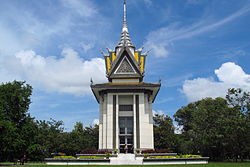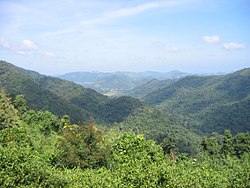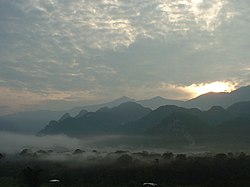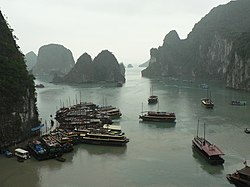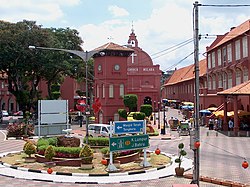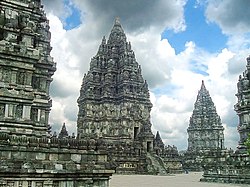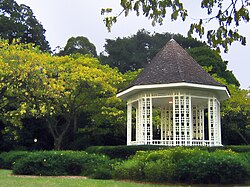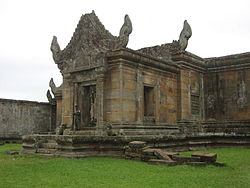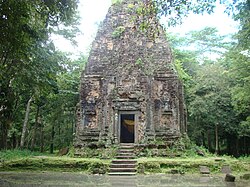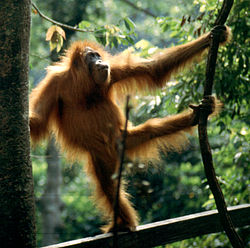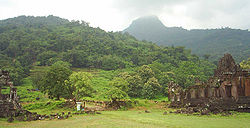Top Qs
Timeline
Chat
Perspective
List of World Heritage Sites in Southeast Asia
From Wikipedia, the free encyclopedia
Remove ads
The UNESCO (United Nations Educational, Scientific and Cultural Organization) has designated 47 World Heritage Sites in nine countries (also called "State parties") of Southeast Asia: Cambodia, Indonesia, Laos, Malaysia, Myanmar, Philippines, Singapore, Thailand, and Vietnam. Only Brunei and Timor-Leste (East Timor) lack World Heritage Sites.[1][2]
Indonesia lead the list with ten inscribed sites, followed by Vietnam with nine, with Thailand with eight, Malaysia and the Philippines each with six, Cambodia with five, Laos with three, Myanmar with two, and Singapore with one.[3] The first sites from the region were inscribed at the 15th session of the World Heritage Committee in 1991.[4] The latest sites inscribed are Cambodian Memorial Sites: From centres of repression to places of peace and reflection in Cambodia, Forest Research Institute Malaysia Forest Park Selangor in Malaysia and Yen Tu-Vinh Nghiem-Con Son, Kiep Bac Complex of Monuments and Landscapes in Vietnam, inscribed in the 47th session of the Committee in 2025.[5] Each year, UNESCO's World Heritage Committee may inscribe new sites or delist those no longer meeting the criteria, the selection based on ten criteria of which six stand for cultural heritage (i–vi) and four for natural heritage (vii–x);[6] some sites are "mixed" and represent both types of heritage. In Southeast Asia, there are 32 cultural, 14 natural and 1 mixed sites.[3]
The World Heritage Committee may also specify that a site is endangered, citing "conditions which threaten the very characteristics for which a property was inscribed on the World Heritage List." One site in this region, Tropical Rainforest Heritage of Sumatra, is listed as endangered; Angkor and Rice Terraces of the Philippine Cordilleras were once listed but were taken off in 2004 and 2012 respectively.
By comparison with other world regions such as East Asia, South Asia, Middle East, Central America, and Western Europe, the designation of UNESCO sites in the Southeast Asian region has been regarded as 'too few and too slow' since the inception of the 21st century. Scholars from various Southeast Asian nations have suggested for the establishment of an inclusive Southeast Asian body that will cater to the gaps of the region's activities in UNESCO as the majority of nations in the region are underperforming in the majority of the lists adopted by UNESCO, notably the World Heritage List.
Remove ads
Legend
- Site; named after the World Heritage Committee's official designation[3]
- Location; at city, regional, or provincial level and geocoordinates
- Criteria; as defined by the World Heritage Committee[6]
- Area; in hectares and acres. If available, the size of the buffer zone has been noted as well. A value of zero implies that no data has been published by UNESCO
- Year; during which the site was inscribed to the World Heritage List
- Description; brief information about the site, including reasons for qualifying as an endangered site, if applicable.
Remove ads
World Heritage Sites
Summarize
Perspective
† In danger
Location of sites
Southeast Asia has the fewest UNESCO World Heritage Sites in Asia, next to Central and North Asia, despite being the base of the UNESCO Asia-Pacific headquarters located in Bangkok, Thailand and having a diverse line of natural and cultural heritage sites. Due to this, numerous scholars have been calling on Southeast Asian governments to participate and nominate more sites in UNESCO annually.
Various institutions have also criticized UNESCO for its 'Europe-centric' designations. An example of which was when UNESCO declared 10 UNESCO sites in Italy (a European country) in just a single year (1997). During the same time, 8 sites were declared for the entire Asian continent, where no designated site was located in Southeast Asia at all.[61]
Green - Natural; Yellow - Cultural; Blue - Mixed; Red - In danger
Performance of Southeast Asia in UNESCO
The performance of Southeast Asia is contrasted by the performance of South and East Asia. Southeast Asian countries are in blue.

Remove ads
Tentative List
Summarize
Perspective
Brunei and Timor-Leste currently have no tentative list sites. Both Brunei and Timor-Leste are presently undergoing comprehensive research for tentative site submissions [citation needed]. The latest countries revised their tentative lists are the Philippines and Thailand in 2024.
The following lists are the current nomination process for each country.
Cambodia
There are currently 6 sites on the tentative list.
- The Site of Angkor Borei and Phnom Da (2020)
- The Archeological complex of Banteay Chhmar (2020)
- Beng Malea Temple (2020)
- Ancient City of Oudong (2020)
- Phnom Kulen: Archeological Site/Ancient Site of Mahendraparvata (2020)
- The ancient complex of Preah Khan Kompong Svay (2020)
Indonesia
There are currently 19 sites on the tentative list.[62]
- Betung Kerihun National Park (Transborder Rainforest Heritage of Borneo) (2004)
- Bunaken National Park (2005)
- Raja Ampat Islands (2005)
- Taka Bonerate National Park (2005)
- Wakatobi National Park (2005)
- Derawan Islands (2005)
- Tana Toraja Traditional Settlement (2009)
- Bawomataluo Site (2009)
- Muara Takus Compound Site (2009)
- Muarajambi Temple Compound (2009)
- Trowulan - Former Capital City of Majapahit Kingdom (2009)
- Prehistoric Cave Sites in Maros-Pangkep (2009)
- Sangkulirang - Mangkalihat Karts: Prehistoric rock art area (2015)
- The Old Town of Jakarta (Formerly old Batavia) and 4 outlying islands (Onrust, Kelor, Cipir dan Bidadari) (2015) (Nominated in 2018)[63]
- Semarang Old Town (2015)
- Traditional Settlement at Nagari Sijunjung (2015)
- The Historic and Marine Landscape of the Banda Islands (2015)
- Kebun Raya Bogor (2018)
- Tropical Rainforest Heritage of Sumatra – Significant Boundary Modification (2023)
Laos
There are currently 2 sites on the tentative list.
- That Luang of Vientiane (1992)
- Hin Nam No National Protected Area (2019)
Malaysia
There are currently 5 sites on the tentative list.
- National Park (Taman Negara) of Peninsular Malaysia (2014)
- FRIM Selangor Forest Park (2017)
- Gombak Selangor Quartz Ridge (2017)
- Royal Belum State Park (2017)
- Sungai Buloh Leprosarium (2019)
Myanmar
There are currently 15 sites on the tentative list.[64]
- Wooden Monasteries of Konbaung Period: Ohn Don, Sala, Pakhangyi, Pakhannge, Legaing, Sagu, Shwe-Kyaung (Mandalay) (1996)
- Badah-lin and associated caves (1996)
- Ancient cities of Upper Myanmar: Innwa, Amarapura, Sagaing, Mingun, Mandalay (1996)
- Mrauk-U (1996)
- Inle Lake (1996)
- Mon cities: Bago, Hanthawaddy (1996)
- Ayeyawady River Corridor (2014)
- Hkakabo Razi Landscape (2014)
- Indawgyi Lake Wildlife Sanctuary (2014)
- Natma Taung National Park (2014)
- Myeik Archipelago (2014)
- Hukaung Valley Wildlife Sanctuary (2014)
- Taninthayi Forest Corridor (2014)
- Pondaung anthropoid primates palaeontological sites (2018)
- Shwedagon Pagoda on Singuttara Hill (2018)
Philippines
There are currently 25 sites on the tentative list.[65]
- Batanes Protected landscapes and seascapes (1993)
- The Tabon Cave Complex and all of Lipuun (2006)
- Paleolithic Archaeological Sites in Cagayan Valley (2006)
- Kabayan Mummy Burial Caves (2006)
- Butuan Archeological Sites (2006)
- Baroque Churches of the Philippines (Extension) (2006)
- Petroglyphs and Petrographs of the Philippines (2006)
- Neolithic Shell Midden Sites in Lal-lo and Gattaran Municipalities (2006)
- Chocolate Hills Natural Monument (2006)
- Mt. Malindang Range Natural Park (2006)
- Mt. Pulag National Park (2006)
- Apo Reef Natural Park (2006)
- El Nido-Taytay Managed Resource Protected Area (2006)
- Coron Island Natural Biotic Area (2006)
- Mt. Iglit-Baco National Park (2006)
- Northern Sierra Madre Natural Park and outlying areas inclusive of the buffer zone (2006)
- Mt. Mantalingahan Protected Landscape (2015)
- Mayon Volcano Natural Park (MMVNP) (2015)
- Turtle Islands Wildlife Sanctuary (2015)
- The Sugar Cultural Landscape of Negros and Panay Islands (2024)
- The Historic Towns and Landscape of Taal Volcano and its Caldera Lake (2024)
- Colonial Urban Plan and Fortifications of the Walled City of Manila (2024)
- Agusan Marsh Wildlife Sanctuary (2024)
- Kitanglad and Kalatungan Mountain Ranges: Sacred Sites of Bukidnon (2024)
- Corregidor Island and Historic Fortifications of Manila Bay (2024)
- Samar Island Natural Park (2024)
- Prehistoric Sites of the Cagayan Valley Basin (2024)
- Rice Terraces of the Philippine Cordilleras (Extension) (2024)
- Mount Hamiguitan Range Wildlife Sanctuary (Extension) – Pujada Bay (2024)
Singapore
There is currently 1 site on the tentative list.
- The Padang Civic Ensemble (2022)
Thailand
There are currently 6 sites on the tentative list.[66]
- Wat Phra Mahathat Woramahawihan, Nakhon Si Thammarat (2012)
- Monuments, Sites and Cultural Landscape of Chiang Mai, Capital of Lanna (2015)
- Phra That Phanom, its related historic buildings and associated landscape (2017)
- Ensemble of Phanom Rung, Muang Tam and Plai Bat Sanctuaries (2019)
- The Andaman Sea Nature Reserves of Thailand (2021)
- Songkhla and its Associated Lagoon Settlements (2024)
- Phra Prang of Wat Arun Ratchawararam: The Masterpiece of Krung Rattanakosin (2025)
Vietnam
There are currently 7 sites on the tentative list.
- Huong Son Complex of Natural Beauty and Historical Monuments (1991)
- The Area of Old Carved Stone in Sapa (1997)
- Cat Tien National Park (2006)
- Con Moong Cave (2006)
- Ba Be - Na Hang Natural Heritage Area (2017)
- The Yen Tu Complex of Monuments and Landscapes (2021)
- Oc Eo - Ba The archaeological site (2022)
Remove ads
See also
- Intangible Cultural Heritage Register of Southeast Asia
- Southeast Asia Memories of the World Register
- UNESCO Biosphere Reserves of Southeast Asia
- List of World Heritage Sites in Cambodia
- List of World Heritage Sites in Indonesia
- List of World Heritage Sites in Malaysia
- List of World Heritage Sites in the Philippines
- List of World Heritage Sites in Thailand
- List of World Heritage Sites in Vietnam
Remove ads
Notes
- First inscription as Ha Long Bay. Extended inscription in 2000 to include natural criterion (i) (in present nomenclature criterion (vii)) and extended again in 2023 to include Cat Ba Archipelago and name change to the present name.
- First inscription as Tubbataha Reef Marine Park. Extended in 2009 and name change to the present name.
References
General sources
Wikiwand - on
Seamless Wikipedia browsing. On steroids.
Remove ads






